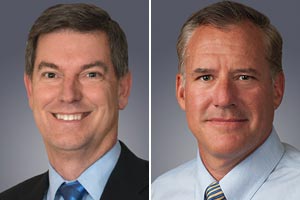Cummins Promotes Two; Freeland Named President

This story appears in the July 14 print edition of Transport Topics.
Cummins Inc. has promoted Rich Freeland to president and chief operating officer and has tapped Dave Crompton to succeed Freeland at the helm of the company’s engine business.
The changes, effective July 8, represent an expansion of Cummins’ leadership team to better position it for further growth, the company said.
“As we continue to grow profitably around the world, we want to have a leadership team capable of meeting our demanding short-term targets every day, while making the right long-term strategic investments necessary to sustain future profitable growth,” CEO Tom Linebarger announced.
The company’s president and COO position had been vacant since 2012, when Linebarger, the most recent executive to hold those titles, became CEO.
In his new role, Freeland will oversee daily operations at the independent engine maker, which sells more Class 8 truck engines in North America than any other manufacturer.
Before his promotion, Freeland was president of the company’s engine segment, its largest business unit, since 2010.
Crompton now steps in as the segment’s new president after spending more than 25 years in a variety of roles within that business. He previously led the engine unit’s heavy-duty, midrange and light-duty segment.In an interview with Transport Topics, Freeland said Cummins remains focused on building its scale globally and growing profitably.
“We know we’re in cyclical businesses, but we’re committed to growth,” he said. “It’s not a change in direction, going forward.”
Cummins, which does business in 190 countries, likes the fact that emissions are getting tougher around the world, Freeland said. “We think that’s an advantage for us because we’ve developed that capability.”
Cummins is working closely with the trucking and the Environmental Protection Agency to provide input for the next round of emissions requirements for greenhouse gases that took effect this year and will take effect in 2017, he said.
“I think the next decade will be all about who is best in fuel economy,” he said. “We like being in that race.”
Crompton said Cummins is well-positioned for the next round.
“Given the investments we’ve made in the past two cycles, we feel really good about the suite of technologies that we have,” he said. “The future is about how you integrate and how you optimize for the customer. That’s what we’re focused on.”
Although truck makers continue to tout the benefits of their proprietary engines and vertical integration, Freeland said truck OEMs and end customers continue to demand Cummins’ products.
Last year, the Columbus, Indiana-based manufacturer captured 40.4% of the North American engine market for Class 8 trucks, according to WardsAuto.com.
Freeland said Cummins continues to work internally to squeeze additional efficiencies from its components while also partnering with other suppliers such as transmission maker Eaton Corp.
“That’ll be a key part of the strategy — reaching out and finding ways to collaborate better,” he said.
Freeland, who joined Cummins in 1979, has led three of the company’s four business units during his career. Before he guided the engine business, he was president of components and president of distribution.
“Rich has a deep understanding of Cummins’ business, people, customers and markets, which will be invaluable in his new role,” Linebarger said.
The company launched a record number of products and expanded its global partnerships during Freeland’s tenure as engine president.
Cummins credited Crompton with guiding the integration of the engine segment’s heavy-, medium- and light-duty businesses into a seamless global organization.
“Dave has helped our engine business expand global partnerships, improve quality and navigate through some of the most strategic and economic challenges our company has faced,” Linebarger said.
On the subject of natural gas in trucking, Freeland said “there’s clearly a place” for the alternative fuel in the North American heavy-duty truck market, but some of the hype about the speed of adoption was “a bit overblown,” given constraints such as service and refueling capabilities and the uncertainty of equipment resale values.
“We don’t see it going to 30% of the market in a couple years or anything like that,” he said.
Freeland said natural gas represents about 2% of the market now, and he predicted that it will continue to grow, but at a gradual pace.
“The people who have it like it,” he said. “I think we’re going to see it grow, but we just don’t see a short-term inflection point where this thing turns over and moves to natural gas quickly.”
Freeland said the ISX12 G natural-gas engine made with Westport Innovations has seen strong acceptance since its launch last year.

